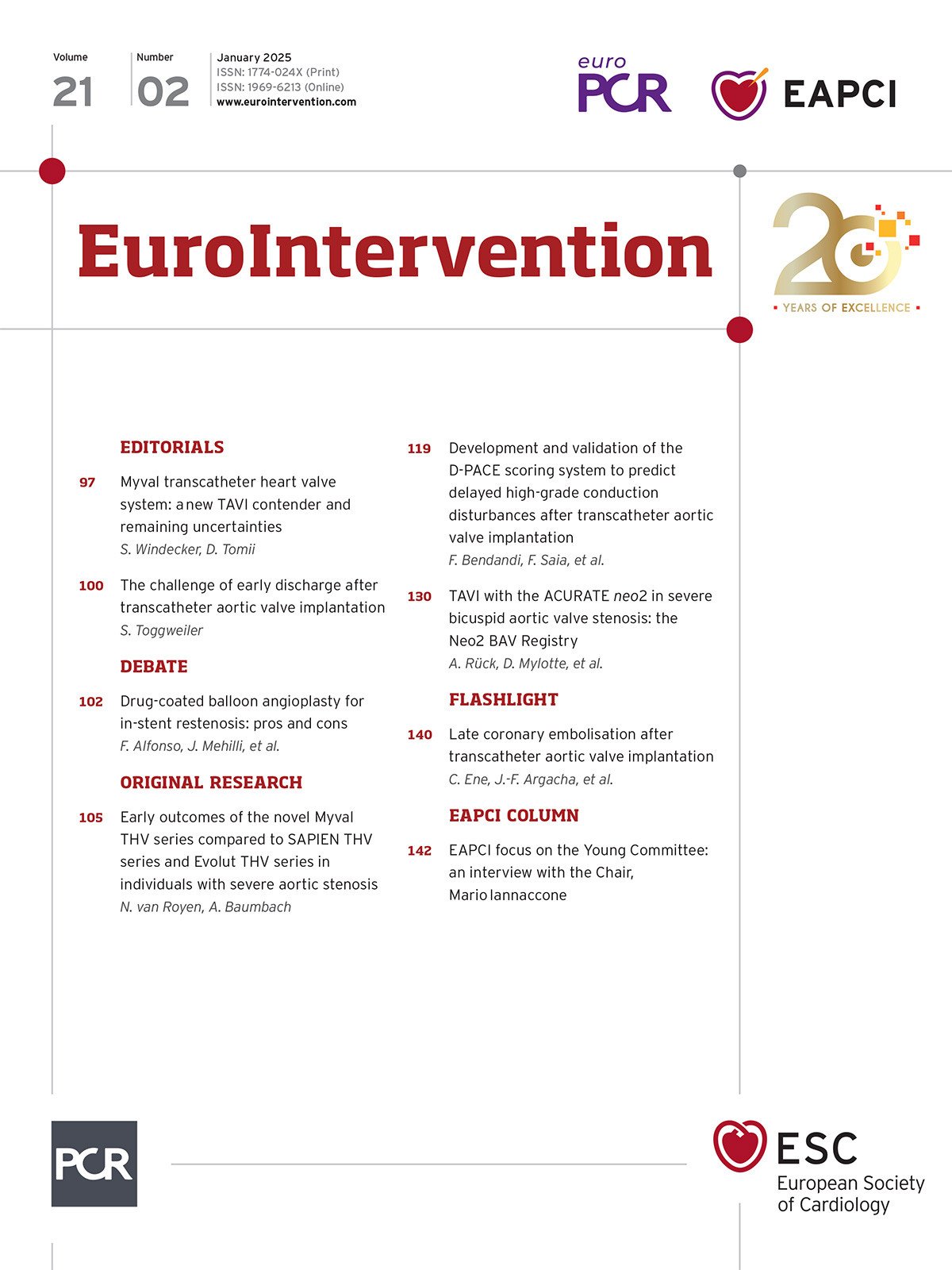Original Research
DOI: 10.4244/EIJ-D-24-00951
Early outcomes of the novel Myval THV series compared to SAPIEN THV series and Evolut THV series in individuals with severe aortic stenosis
Niels van Royen1, MD, PhD; Ignacio J. Amat-Santos2,3, MD, PhD; Martin Hudec4, MD, PhD; Matjaz Bunc5, MD, PhD; Alexander Ijsselmuiden6,7, MD, PhD; Peep Laanmets8, MD; Daniel Unic9, MD, PhD; Béla Merkely10, MD; Renicus S. Hermanides11, MD, PhD; Vlasis Ninios12, MD; Marcin Protasiewicz13, MD, PhD; Benno J.W.M. Rensing14, MD, PhD; Pedro L. Martin15, MD, PhD; Fausto Feres16, MD; Manuel De Sousa17, MD, PhD; Eric Van Belle18, MD, PhD; Axel Linke19, MD; Alfonso Ielasi20, MD; Matteo Montorfano21,22, MD; Mark Webster23, MBChB; Konstantinos Toutouzas24, MD, PhD; Emmanuel Teiger25, MD, PhD; Francesco Bedogni26, MD; Michiel Voskuil27, MD, PhD; Manuel Pan28, MD, PhD; Oskar Angerås29,30, MD, PhD; Won-Keun Kim31,32, MD; Jürgen Rothe33,34, MD; Ivica Kristić35, MD, PhD; Vicente Peral36, MD, PhD; Ben J.L. Van den Branden6, MD; Dirk Westermann33, MD; Barbara Bellini22, MD; Mario Garcia-Gomez2,3, MD; Akihiro Tobe37, MD; Tsung-Ying Tsai37,38, MD; Scot Garg39,40, MD, PhD; Ashokkumar Thakkar41, PhD; Udita Chandra41, PhD; Marie-Claude Morice42,43, MD, PhD; Osama Soliman37, MD, PhD; Yoshinobu Onuma37,44, MD, PhD; Patrick W. Serruys37, MD, PhD; Andreas Baumbach45,46, MD, PhD
1. Department of Cardiology, Radboud University Hospital, Nijmegen, the Netherlands; 2. Centro de Investigación Biomédica en Red - Enfermedades Cardiovasculares (CIBERCV), Instituto de Salud Carlos III, Madrid, Spain; 3. Department of Cardiology, Hospital Clínico Universitario de Valladolid, Valladolid, Spain; 4. Department of Acute Cardiology, Middle-Slovak Institute of Cardiovascular Diseases, Banska Bystrica, Slovakia; 5. Department of Cardiology, University Medical Centre Ljubljana, Ljubljana, Slovenia; 6. Department of Cardiology, Amphia Hospital, Breda, the Netherlands; 7. Zuyderland Hospital, Limburg, the Netherlands; 8. Department of Invasive Cardiology, North Estonia Medical Centre, Tallinn, Estonia; 9. Department of Cardiac and Transplant Surgery, University Hospital Dubrava, Zagreb, Croatia; 10. Heart and Vascular Center, Semmelweis University, Budapest, Hungary; 11. Department of Cardiology, Isala Hospital, Zwolle, the Netherlands; 12. Department of Cardiology, European Interbalkan Medical Center, Thessaloniki, Greece; 13. Department of Cardiology, Institute of Heart Diseases, Wroclaw Medical University, Wroclaw, Poland; 14. Department of Cardiology, St Antonius Hospital, Nieuwegein, the Netherlands; 15. Department of Interventional Cardiology, University Hospital of Gran Canaria Dr Negrín, Las Palmas de Gran Canaria, Spain; 16. Department of Invasive Cardiology, Instituto Dante Pazzanese, São Paulo, Brazil; 17. CHRC, NOVA Medical School, NOVA University Lisbon, Lisbon, Portugal; 18. Department of Interventional Cardiology, Lille University, Lille, France; 19. Department of Internal Medicine and Cardiology, University Clinic, Heart Center Dresden, University of Technology Dresden, Dresden, Germany; 20. Department of Interventional Cardiology, IRCCS Ospedale Galeazzi Sant’Ambrogio, Milan, Italy; 21. 22. School of Medicine, Vita-Salute San Raffaele University, Milan, Italy; 22. Interventional Cardiology Unit, IRCCS San Raffaele Scientific Institute, Milan, Italy; 23. Department of Cardiology, Auckland City Hospital, Auckland, New Zealand; 24. Department of Cardiology, Hippokration Hospital, Athens, Greece; 25. Department of Interventional Cardiology, Henri Mondor University Hospital, Créteil, France; 26. Department of Clinical Cardiology, San Donato Hospital, Milan, Italy; 27. Department of Cardiology, University Medical Center Utrecht, Utrecht, the Netherlands; 28. Department of Cardiology, University Hospital Reina Sofía, University of Córdoba, IMIBIC, CIBERCV, Córdoba, Spain; 29. Department of Cardiology, Sahlgrenska University Hospital, Gothenburg, Sweden; 30. Department of Molecular and Clinical Medicine, Institute of Medicine, University of Gothenburg, Gothenburg, Sweden; 31. Department of Cardiology & Angiology, University of Giessen and Marburg, Gießen, Germany; 32. Department of Cardiology, Kerckhoff Heart Center, Bad Nauheim, Germany; 33. Department of Cardiology and Angiology, Campus Bad Krozingen, University Heart Center-University of Freiburg, Bad Krozingen, Germany; 34. Faculty of Medicine, University of Freiburg, Freiburg, Germany; 35. Department of Cardiology, University Hospital of Split, Split, Croatia; 36. Department of Cardiology University Hospital Son Espases, Health Research Institute of the Balearic Islands (IdISBa), Palma, Balearic Islands, Spain; 37. Department of Cardiology, School of Medicine, University of Galway, Galway, Ireland; 38. Cardiovascular Center, Taichung Veterans Hospital, Taiwan; 39. Department of Cardiology, Royal Blackburn Hospital, Blackburn, United Kingdom; 40. School of Medicine, University of Central Lancashire, Preston, United Kingdom; 41. Department of Clinical Research, Meril Life Sciences Pvt. Ltd., Vapi, India; 42. Cardiovascular European Research Center (CERC), Massy, France; 43. ICPS, Hôpital privé Jacques Cartier, Massy, France; 44. Galway University Hospital, Galway, Ireland; 45. Centre for Cardiovascular Medicine and Devices, William Harvey Research Institute, Queen Mary University of London and Barts Heart Centre, London, United Kingdom; 46. Cleveland Clinic, London, United Kingdom

